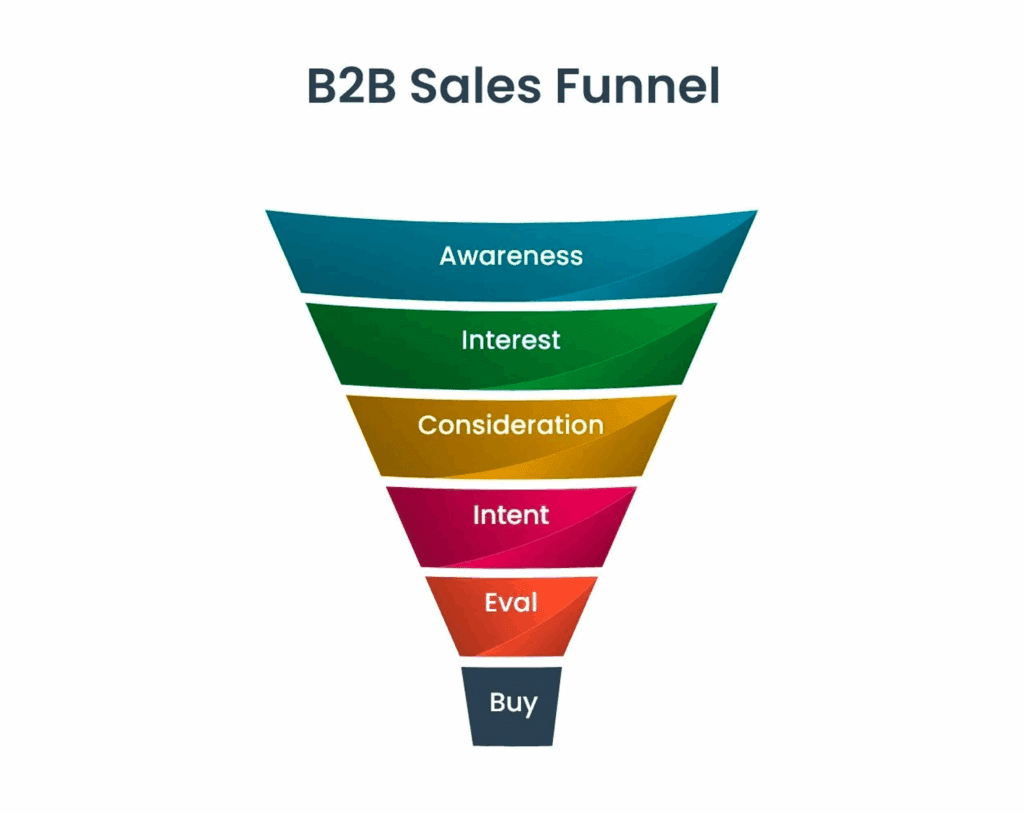Table of Contents
Why Funnel Optimization Is a Strategic Growth Lever
The Strategic Blueprint: Deconstructing the B2B Funnel
Identifying Bottlenecks with Funnel Analytics
Strategic Levers to Improve Funnel Performance
Lead Nurturing Beyond the Top of Funnel
Operationalizing Continuous Funnel Optimization
Measuring Impact and ROI
Final Thoughts: Funnel Optimization as a C-Suite Growth Strategy
Recommended Blogs to Continue Learning
Optimizing Your B2B Marketing Funnel Stages for Peak Revenue Conversion
Is your B2B marketing funnel leaking high-value opportunities at key handoff points? If so, you’re not alone. Many C-suite leaders face the challenge of unpredictable revenue and underperforming marketing ROI—not due to a lack of leads, but because of breakdowns between stages in the funnel. A strong B2B funnel optimization strategy isn’t about minor tweaks—it’s about transforming your funnel into a high-conversion revenue engine.

Why Funnel Optimization Is a Strategic Growth Lever
The B2B buying journey involves multiple stakeholders, long sales cycles, and handoffs between departments. At each transition—from MQL to SQL, SQL to Opportunity, Opportunity to Customer—potential deals are lost. These leaks inflate CAC, slow down revenue generation, and damage forecast accuracy.
Yet, even modest improvements at key conversion points can lead to exponential growth. Increasing the MQL-to-SQL rate by just 10% can lead to a significant increase in closed deals downstream. A B2B funnel optimization strategy, therefore, is not tactical—it’s foundational to sustainable growth.
The Strategic Blueprint: Deconstructing the B2B Funnel
To optimize for revenue, you must analyze your funnel as an operational blueprint:
Common Funnel Stages:
- Awareness: The buyer identifies a problem.
- Engagement: Interactions begin (content, website, ads).
- MQL: Marketing-qualified lead based on defined behaviors.
- SQL: Sales-approved lead ready for deeper engagement.
- Opportunity: Actively involved in a sales process.
- Customer: The deal closes.
Critical Handoff Points:
- MQL → SQL: Where marketing and sales alignment is vital.
- SQL → Opportunity: Requires strong qualification.
- Opportunity → Close: Relies on frictionless sales enablement.
Identifying Bottlenecks with Funnel Analytics
Key Metrics to Monitor:
- Conversion Rates by Stage
- Pipeline Velocity
- Lead-to-Opportunity Rate
- Opportunity-to-Close Rate
- CAC Impact by Drop-Off Point
Use funnel charts and analytics dashboards to spot where prospects drop out. Combine this quantitative insight with qualitative input from sales, customer success, and even lost prospects. These steps form the foundation of an effective B2B funnel optimization strategy.

Strategic Levers to Improve Funnel Performance
1. Align Sales and Marketing
- Develop shared definitions (MQL, SQL).
- Create a Service Level Agreement (SLA).
- Use a unified Ideal Customer Profile (ICP).
2. Optimize Critical Transitions
MQL to SQL:
- Refine lead scoring models.
- Personalize lead enrichment.
- Improve follow-up speed and messaging.
- Establish a feedback loop from Sales.
SQL to Opportunity:
- Use advanced qualification frameworks (e.g., MEDDIC).
- Streamline internal handoffs.
- Provide sales with detailed buyer insights.
Opportunity to Close:
- Standardize the sales process.
- Improve forecasting.
- Address objections early with win/loss insights.
- Invest in deal enablement tools.
Lead Nurturing Beyond the Top of Funnel
Lead nurturing should extend from Awareness to Close:
Strategic Nurturing Tactics:
- Segment by stage, persona, and intent.
- Personalize based on behavior and industry.
- Align content to funnel stage.
- Automate triggered nurture flows.
- Track nurturing ROI through conversion rate and velocity.
Operationalizing Continuous Funnel Optimization
Optimization is not a one-time project—it’s a strategic process:
Continuous Optimization Framework:
- Analyze performance.
- Develop strategic hypotheses.
- Implement changes.
- Measure impact.
- Refine based on results.
Ensure alignment between Sales, Marketing, Success, and Product teams. Leverage technology (CRM, analytics, automation) to scale efforts and uncover insights.
Measuring Impact and ROI
Funnel Optimization Success Metrics:
- Stage-by-stage conversion improvement.
- CAC reduction.
- LTV growth.
- Revenue velocity acceleration.
- Forecast accuracy.
Tie these outcomes to individual initiatives using ROI modeling to justify continued optimization investments. A well-documented B2B funnel optimization strategy ensures measurable outcomes.
Final Thoughts: Funnel Optimization as a C-Suite Growth Strategy
A well-optimized B2B funnel isn’t just efficient—it’s predictive. By identifying and fixing the most impactful conversion bottlenecks, aligning teams around shared revenue goals, and embedding optimization into your operating model, you transform your funnel from leaky to high-converting.
With a strategic B2B funnel optimization strategy in place, you’ll lower CAC, boost LTV, create predictable revenue—and build a long-term competitive advantage.
Recommended Blogs to Continue Learning=
Looking to dive deeper into funnel strategy and performance marketing? Explore these related reads from Sales Funnel Professor:
- Your Shortcut to High Velocity Funnels: Master Brand Positioning Strategy
- Revenue Consulting: The Strategic Lever for Scalable Growth
- Sales Funnel Metrics That Drive Revenue
- Funnel Metrics Best Practices
- How to Grow a Digital Marketing Agency: 10 Sales Funnel Leaks You Can Plug
Stay tuned to SalesFunnelProfessor.com/blog for more expert insights.


